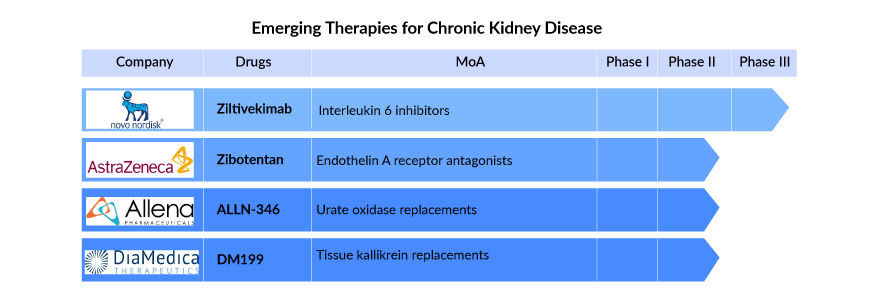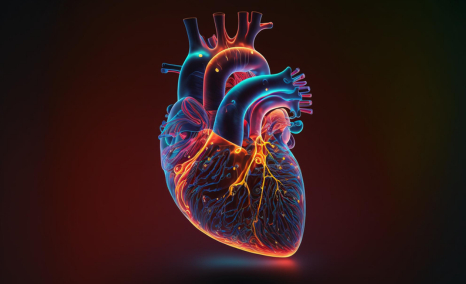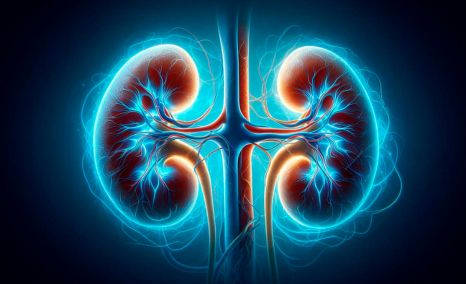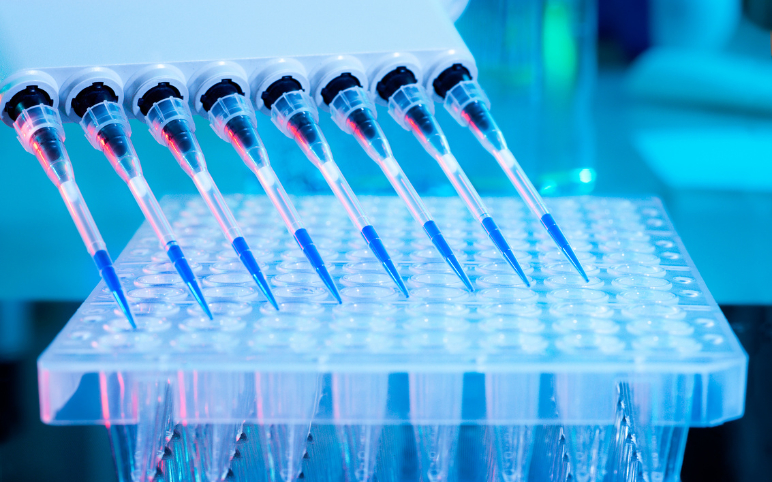Evolving Therapeutics in Chronic Kidney Disease (CKD) Treatment Market
Jun 12, 2023
Table of Contents
Chronic kidney disease burden and diagnostic barriers
Chronic kidney disease (CKD) is a progressive and irreversible ailment characterized by gradual loss of kidney function. It is clinically defined by a glomerular filtration rate of less than 60mL/min/1.73m2 or albuminuria of at least 30mg per 24 hours, or any occurrence of markers for kidney damage. The disease has a high patient burden.
According to Delveinsight’s “Chronic Kidney Disease Epidemiology Forecast” report, almost 76 million people are affected in the 7MM countries. Further, it has been estimated that less than a quarter of these patients are actually diagnosed with the condition suggesting an abysmally low awareness of the disease. The disease is detected only when it progresses to more severe stages, with more than two-thirds of the cases being diagnosed in Stage 3 and above. These diagnostic delays augment the already overwhelmed healthcare system.
Downloads
Click Here To Get the Article in PDF
Recent Articles
- Evotec, Chinook Teams Up for CKD Therapy; HitGen & UPPTHERA in Drug Delivery Research; Artiv...
- ACC.25 Highlights: Groundbreaking Advances in Cardiovascular Medicine and Emerging Therapeutics
- AstraZeneca’s Voydeya FDA Approval; Akebia’s Vafseo FDA Approval; Bristol Myers Squibb’s Phase II...
- B. Braun’s Introcan Safety 2 IV Catheter; Everly Health’s At-Home Collection Kidney Health Test; ...
- Ardelyx Overcomes Hurdles to Secure FDA Approval for Xphozah in Chronic Kidney Disease Treatment
Chronic kidney disease etiologies
CKD may be a result of a combination of different complications. It occurs when a disease impairs kidney function, causing kidney damage over time. The most prominent cause of CKD is diabetes, followed by hypertension. Polycystic kidney disease –a genetic disease—may also result in the loss of renal function. Other causes may include glomerular diseases (such as glomerulonephritis, IgA nephropathy), or infection. As multiple chronic kidney disease drugs are prescribed to treat comorbidities, and almost half of these are eliminated via the kidney, the chances of drug toxicity increase making it an additional cause for concern.

Conventional chronic kidney disease treatment and associated unmet need
Renin angiotensive system inhibitors (RAS inhibitors) which include Angiotensive receptor blockers (ARBs) and Angiotensin-converting enzyme inhibitors (ACE inhibitors) have been the cornerstones of chronic kidney disease treatment for around two decades, due to their renal protecting mechanisms. Diabetes-associated kidney disease patients (DKD), which is the major pool for CKD, are also given antidiabetic drugs focusing on glycemic control such as metformin, sodium-glucose cotransporter 2 inhibitor (SGLT2 inhibitor), and Glucagon-like peptide 1 (GLP1 drugs) along with the traditional antihypertensive drugs. In the case of hypertension-induced CKD patients it is crucial to manage high blood pressure and drugs such as ACE inhibitors/ARBs, calcium channel blockers, and diuretics are usually prescribed. Despite available chronic kidney disease treatments, however, there is continued progression of the disease along with the chances of therapy-induced rapid renal deterioration and hyperkalemia.
Broadening chronic kidney disease therapeutic approaches
Mineralocorticoid receptor antagonists (MRAs) is a class of drugs used to retard CKD progression. Pathophysiological over-activation of the mineralocorticoid receptors expressed in the kidneys can lead to inflammation and fibrosis. Spironolactone, a steroidal MRA, has been known to reduce albuminuria in people with diabetes and elevated urinary albumin; however, there are concerns regarding the risk for hyperkalemia and acute kidney injury (AKI). In contrast, non-steroidal MRA such as Finerenone, approved under the brand name KERENDIA (Bayer) has shown to have more potent anti-inflammatory and antifibrotic effects than steroidal MRAs while also cutting the risk of sudden cardiac death in these patients.

SGLT2 inhibitors are another important class of drugs used to lower blood sugar levels in adults with type 2 diabetes while preventing the kidneys from reabsorbing sugar that is created by the body. Johnson & Johnson’s Invokana (Canagliflozin), one such SGLT2 inhibitor, is used to slow the progression of kidney damage in patients with diabetic kidney disease (DKD). AstraZeneca’s Farxiga (Dapagliflozin) boasts approval for both diabetic and non-diabetic patients with CKD, which has opened a massive chronic kidney disease market opportunity for it. As per Delveinsight’s estimates on the latest published “Chronic Kidney Disease Market Report, in the United States, Farxiga achieved sales of USD 111 million in its launch year and is estimated to see considerable growth, reaching peak sales of USD 560 million.
Emerging chronic kidney disease pipeline and their mechanisms
There has been impressive interest in the chronic kidney disease treatment market over the years with several pharma players such as Prokidney, KBP Biosciences, Boehringer Ingelheim Pharmaceuticals/Lilly, Reata Pharmaceuticals, Inc., and Novo Nordisk vying for a share of the pie. Prokidney is developing a renal autologous cell therapy (REACT) for DKD patients, to restore kidney function using the patient’s cells. Novo Nordisk’s Semaglutide, GLP-1 receptor agonist being investigated in Phase III is also targeting DKD patients. For the overall chronic kidney disease pool, there are drugs in mid/late stages of development such as Boehringer Ingelheim’s Jardiance (Empagliflozin), Reata Pharmaceuticals’ Bardoxolone methyl, and Novo Nordisk’s Ziltivekimab. Jardiance is currently approved to lower blood sugar and reduce the risk of cardiovascular death in adults with type 2 diabetes. In 2022, Eli Lilly and Boehringer Ingelheim submitted a supplementary New Drug Application for the drug as a prospective treatment for mitigating the risk of end-stage kidney disease. This was based on the results of the EMPA-KIDNEY Phase III trial, the largest and broadest dedicated SGLT2 inhibitor trial in chronic kidney disease treatment to date. In 2023, FDA accepted the application causing the drug to advance toward its approval for overall chronic kidney disease and compete with rival FARXIGA. Bardoxolone methyl, an NF-kappa B inhibitor, is in phase III trial. In Japan, the drug is being investigated for diabetic patients by Kyowa Kirin Co., Ltd, in collaboration with the drug originator, Reata Pharmaceuticals. Ziltivekimab is a monoclonal antibody, currently in Phase III trial, and has shown good efficacy in its previous chronic kidney disease clinical trials.

Changes anticipated in the chronic kidney disease treatment paradigm and market
Jardiance, an already celebrated drug for diabetes and heart failure patients, awaits approval for CKD in 2023, marking another important milestone for Eli Lilly and Boehringer Ingelheim. As per Delveinsight, the chronic kidney disease drug is expected to gain a sizeable market share, attaining an estimated peak sales of USD 700-800 million in the US. Bardoxolone methyl and Ziltivekimab are expected to hit the US chronic kidney disease treatment market in 2026 and 2027 with estimated launch sales of USD 3 million and USD 9 million, respectively. In the DKD market, the REACT therapy being a novel mechanism is expected to spark considerable interest and its value market share will be driven by its significant cost on account of being a cell therapy.
CKD is a complex disease and treatment will be based on the patient’s needs. As emerging chronic kidney disease drugs are targeting different mechanisms of action, judicious use of therapies with the right dosage recommendations is essential to safeguard renal function decline and manage the disease.
FAQs
Chronic kidney disease occurs when the kidneys get damaged and cannot filter blood as efficiently as they should. Chronic kidney disease is defined as abnormalities in kidney structure or function that have been present for more than three months and have a negative impact on health. Chronic kidney disease is categorized into five phases based on the extent of kidney damage and function. In stage 1, there is modest kidney disease, and in stage 5, the kidneys have stopped working. The severity of chronic kidney disease varies.
In the early stages of kidney disease, there are usually no chronic kidney disease symptoms. It can only be diagnosed if a blood or urine test is performed for another reason and the results show a kidney issue. Tiredness, swollen ankles, feet, or hands, shortness of breath, unwellness, and blood in the urine indicate a more advanced stage.
Chronic kidney disease can be detected using blood and urine tests. The eGFR blood test measures the efficiency with which the kidneys function. Ultrasound, CT scan, X-ray, and MRI imaging examinations are also used for chronic kidney disease diagnosis.
There is no cure for CKD, however, treatment can help ease symptoms and keep it from worsening. The treatment approach involves dietary and lifestyle adjustments, as well as medications to decrease blood pressure, blood sugar, or cholesterol. Diuretics are medications that help the kidneys excrete water and reduce edoema. In some circumstances, dialysis may be required. When the kidneys have failed, as in severe CKD, a kidney transplant may be an option.

Downloads
Article in PDF
Recent Articles
- Recent Inclination of Pharma Companies, Emerging Pipeline Therapies Drive the IgA Nephropathy Mar...
- Amgen Announced the Result of its CodeBreak-200 Trial; FDA Clears Bristol-Myers Squibb’s Deucrava...
- New Asundexian Phase III Study Result; Zibotentan/Dapagliflozin Combination Demonstrated Signific...
- AstraZeneca’s Voydeya FDA Approval; Akebia’s Vafseo FDA Approval; Bristol Myers Squibb’s Phase II...
- Ardelyx Overcomes Hurdles to Secure FDA Approval for Xphozah in Chronic Kidney Disease Treatment



